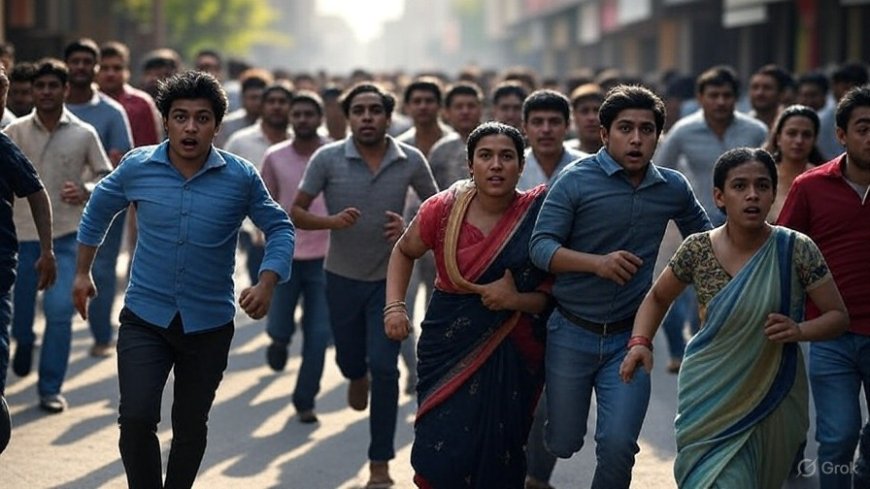Bengaluru Stampede Tragedy Triggers Political Blame Game: Who’s Accountable?
A tragic stampede in Bengaluru has claimed multiple lives, sparking political uproar and blame-shifting among Karnataka's ruling and opposition parties. Here's a detailed look at what happened, who’s being held accountable, and how the incident unfolded.

Stampede in Bengaluru Leaves Several Dead and Injured, Triggers Political Firestorm
A routine food distribution drive in Bengaluru turned into a horrifying tragedy on June 4, 2025, when a stampede broke out in the Mangammanapalya locality, resulting in the deaths of at least six women and leaving more than a dozen others seriously injured. The incident has quickly escalated beyond a civic tragedy into a political flashpoint, with opposition parties blaming the ruling Congress government for “utter mismanagement” and “criminal negligence.”
As per initial reports from The Hindu, the stampede occurred during the early morning hours when hundreds of women gathered at a private venue for free ration kits reportedly being distributed ahead of the upcoming municipal polls. The crowd, far larger than what the organizers had anticipated, surged toward the venue gate, leading to chaos, injuries, and fatalities.
What Caused the Stampede?
The distribution was organized without prior police permission, according to Bengaluru Police Commissioner B. Dayananda. The event had reportedly been publicized in advance, drawing an overwhelming crowd, mostly women from economically weaker sections, eager to collect rice, pulses, and other essentials.
Key contributing factors included:
-
Lack of crowd control mechanisms like barricades or entry management.
-
Insufficient coordination with local police and disaster response teams.
-
Unregulated announcements that heightened the crowd size unexpectedly.
An initial investigation has found that the event was allegedly orchestrated by local Congress functionaries, although the state government has distanced itself from the organizers.
The Political Blame Game Begins
The tragedy has snowballed into a major political controversy. Karnataka BJP leaders, including former Chief Minister Basavaraj Bommai, have launched scathing attacks on the Congress-led state government, accusing it of using welfare events for political gain.
"This is nothing but murder due to negligence. The Congress government must own responsibility and resign," said Bommai at a press conference, as reported by India Today.
In response, Congress leaders have condemned the incident but denied direct involvement, stating the event was organized by “private individuals.” Karnataka Chief Minister Siddaramaiah expressed deep regret over the loss of lives and has ordered a judicial inquiry into the tragedy.
Meanwhile, the Aam Aadmi Party (AAP) and other opposition groups have demanded strict action against both event organizers and complicit officials.
Government Response and Public Reaction
Chief Minister Siddaramaiah visited the injured at St. John’s Medical College and announced compensation of ₹5 lakh for the families of the deceased and ₹1 lakh for the injured. The government has also ordered:
-
A high-level probe led by a retired High Court judge.
-
Suspension of BBMP officials who allegedly failed to report the event or provide safety clearance.
-
Enhanced regulation for future mass distribution events, requiring mandatory police presence and crowd management protocols.
Public sentiment, however, remains highly charged. Several local residents and civil society groups have criticized both the administration and political parties for turning a humanitarian crisis into a political spectacle.
For ongoing updates, readers can follow the Karnataka Disaster Management Authority and Bangalore City Police Twitter handles.
Legal and Civic Implications
Legal experts are already weighing in on whether Section 304A of the Indian Penal Code—causing death by negligence—can be invoked against the organizers. The Karnataka State Human Rights Commission has also taken suo motu cognizance of the case and is seeking explanations from district authorities.
This incident has re-ignited a broader debate on event regulation, especially those linked to political or religious patronage. In a city known for its tech-savvy infrastructure, Bengaluru has long struggled with crowd control in public gatherings—from protests and rallies to festival celebrations.
Voices from the Ground
Here’s what some citizens and social workers had to say:
“It’s heartbreaking. These women came for 5 kilos of rice and never returned home,” said Rekha M., a volunteer from Whitefield Rising, speaking to Deccan Herald.
“The stampede shows how fragile our public management still is. It was a preventable tragedy,” added Prof. V. Ramanna, an urban planning expert at IIHS Bengaluru.
Lessons From the Tragedy
This isn't the first time such an incident has occurred in India. Previous stampedes during ration distributions in Uttar Pradesh (2016) and Andhra Pradesh (2022) have shown a pattern of poor coordination, lack of oversight, and political meddling.
The National Disaster Management Authority’s guidelines for crowd control—which include the use of CCTV monitoring, barricades, drone surveillance, and emergency response drills—are seldom enforced at smaller, community-level events.
Final Thoughts
The Bengaluru stampede is a somber reminder of how easily a humanitarian gesture can spiral into tragedy when planning, regulation, and responsibility are compromised. Beyond the political noise, what remains are the grieving families and the unanswered question—could this have been avoided?
As India approaches a new election cycle, events like this highlight the urgent need for decoupling welfare from political theatrics and reinforcing the civic systems that protect lives.


















































